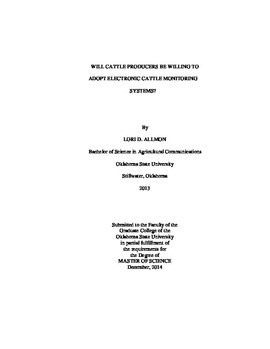| dc.contributor.advisor | Tilley, Daniel S. | |
| dc.contributor.author | Allmon, Lori Dawn | |
| dc.date.accessioned | 2016-01-20T15:44:24Z | |
| dc.date.available | 2016-01-20T15:44:24Z | |
| dc.date.issued | 2014-12-01 | |
| dc.identifier.uri | https://hdl.handle.net/11244/25629 | |
| dc.description.abstract | Monitoring animal health and location is an important task for cattle producers. Historically this is done by visually checking animals in their pastures. An electronic cattle monitoring system could allow producers to monitor their animals' health and location remotely. This study examines cattle producers' willingness to adopt an electronic cattle monitoring system comprised of remote frequency identification rumen boluses, GPS, data collection stations, unmanned aerial vehicles (UAV) and a user interface. The system would allow producers to receive real-time data on the location and health of individual animals. The system could also be configured to allow producers to collect live video, rumen temperature, and/or animal behavioral patterns, among other characteristics. Health and location data would allow producers to not only locate missing cattle but also monitor the health of individual animals in their herd. In order to identify which characteristics and components of the monitoring system are desired by producers, an electronic survey containing demographic, choice experiment, and best worst questions was administered to email lists from the Samuel Roberts Noble Foundation and the Oklahoma Beef Council. Conditional and ordered logit models, willingness to pay estimates, importance scores and individual best-worst scores are used to analyze the results of the survey. The results are used to determine producers' preference for system components and characteristics and producer willingness to adopt the system. Demographic data from the questionnaire are used to determine the demographic characteristics of likely adopting producers. The results suggest that producers who have advanced educational degrees, producers with large numbers of cattle, and producers who infrequently check their cattle are most likely to adopt an electronic cattle monitoring system. Also, producers prefer system characteristics and components that allow them to monitor their animals' health and location such as GPS and notification of altered behavioral patterns. | |
| dc.format | application/pdf | |
| dc.language | en_US | |
| dc.publisher | Oklahoma State University | |
| dc.rights | Copyright is held by the author who has granted the Oklahoma State University Library the non-exclusive right to share this material in its institutional repository. Contact Digital Library Services at lib-dls@okstate.edu or 405-744-9161 for the permission policy on the use, reproduction or distribution of this material. | |
| dc.title | Will Cattle Producers Be Willing to Adopt Electronic Cattle Monitoring Systems? | |
| dc.type | text | |
| dc.contributor.committeeMember | Lusk, Jayson L. | |
| dc.contributor.committeeMember | Calvo-Lorenzo, Michelle S. | |
| osu.filename | Allmon_okstate_0664M_13685.pdf | |
| osu.accesstype | Open Access | |
| dc.description.department | Agricultural Economics | |
| dc.type.genre | Thesis | |
